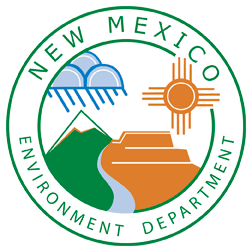The Strategic Water Supply Act (NMSA 72-12C-1 et seq.) establishes the Strategic Water Supply (SWS) Program as a way to protect New Mexico’s freshwater resources through the development and management of brackish water. The Act authorizes the New Mexico Department of Environment (NMED) and the Office of the State Engineer (OSE) to enter into contracts and award grants for projects that utilize treated brackish water. The Strategic Water Supply Fund has an initial appropriation of $40 million available to kick start the program.
2025 Strategic Water Supply Selected Grantees
- Alamo Navajo School Board ($1.83M): Socorro County, Construction of a small-scale brackish water treatment plant to improve public health, water security, and community self-sufficiency.
- City of Anthony ($1.41M): Dona Ana County, Environmental analysis and testing for a brackish groundwater pilot, producing scalable recommendations and a permitting roadmap for statewide use.
- Village of Cuba ($11.7M): Sandoval County, Design of a first-of-its-kind zero-waste desalination facility estimated to produce 518,000 gallons of potable water per day while generating jobs and revenue.
- University of New Mexico ($400K): Bernalillo County, Statewide evaluation of economic and environmental tradeoffs associated with brackish water management.
- Pueblo of Laguna ($6.0M): Sandoval County, Tribal-led feasibility study to characterize brackish water resources and support long-term water resilience.
- New Mexico Institute of Mining & Technology ($1.58M): Socorro County, Advanced membrane research to recover over 98% high-purity water while reducing brine waste and supporting clean-energy supply chains.
- Arrowhead Center at New Mexico State University ($3.0M): Dona Ana County, Establishment of a Brine Valorization Accelerator Hub to convert waste brines into valuable products and build a statewide water-technology ecosystem.
Preparation
To apply for a Strategic Water Supply Grant, please submit preliminary application information. All submitted applicants will be listed on the website. Selected applicants will be invited to move forward in the grant process and may be asked to provide additional documentation that may be necessary to complete the grant.
Eligible Entities
Eligible entities are public entities and federally recognized Indian nations, tribes, or pueblos located wholly or partially in New Mexico. A public entity is defined in the Strategic Water Supply Act as a county, municipality, political subdivision, state agency, or state institution of higher education.
Eligible Projects
Eligible projects include research and demonstration projects, feasibility studies, design pilots, environmental documentation projects, and construction projects. Collectively, projects funded by SWS grants will advance all phases of a brackish water project including the exploration, production, treatment and use of brackish water in New Mexico.
Pursuant to the requirements of the Strategic Water Supply Act, a successful grant project shall:
- be approved by the State Engineer as advancing the exploration, production or treatment of brackish water in New Mexico;
- comply with applicable state, federal, tribal, and local governmental standards and permit requirements and other provisions of law, including public notice, public hearing processes, and all other associated requirements related to public involvement, to protect existing water rights, conservation of water within the state, public welfare, public health, and the environment; and
- clearly demonstrate how the project will advance state, tribal, or local government economic development goals in accordance with the purposes of enhancing the state’s freshwater resources.
Details on Different Project Types
Research and Development

A research and development project involves developing innovative technologies and processes to improve brackish water treatment methods. It can include research to develop a device, equipment, process, or technology aimed at expanding the understanding of new brackish water treatment methods, infrastructure, and management. Research should focus on advancing innovative technologies or methodologies toward practical use. These projects should have a realistic potential to scale up to full implementation, thereby contributing to increased availability of freshwater resources within the state. While research and development/demonstration projects can address specific needs, their primary purpose is not to evaluate individual projects; instead, their outcomes should have broader applicability and impact.
Feasibility Study

A feasibility study assesses the viability of a potential brackish water project, evaluates alternative solutions to achieve the project objectives, and determines the most suitable/preferred option for further action or investment. Feasibility studies can address several key areas to determine project viability, including technical feasibility, economic/financial feasibility, operational feasibility, and legal/regulatory feasibility. Feasibility studies should aim to advance planning to a stage where design, construction, or implementation of a brackish water treatment facility or project can commence. Additionally, environmental documentation or specialized studies needed for permit approval could be included as part of the feasibility study, or as a stand-alone environmental documentation project (See below).
Design Pilot

A planning and design project involves creating a small-scale prototype of a full-scale brackish water treatment project or its components. Its purpose is to refine design criteria, assist in site selection, evaluate specific technologies or methodologies—whether standard or innovative—for implementing a full-scale brackish water treatment facility or project, and demonstrate the prototype system can achieve the treatment objectives. Key elements or components of a design pilot can include constructing or fabricating facilities and treatment approaches, testing equipment and components in various configurations, and analyzing and reporting collected data.
Environmental Documentation / Demonstration

An environmental documentation project is a stand-alone project to demonstrate compliance with state or federal regulations, such as the New Mexico Water Quality Act, the National Environmental Policy Act (NEPA), or other state or federal documentation required for fulfilling permit application requirements. Activities can include funding environmental impact assessments and testing and evaluation needed to meet permitting requirements. A basic feasibility study should already have been completed and there should be a reasonable expectation of project initiation.
Construction

A construction project includes the planning, design, development, or expansion of a full-scale brackish water treatment facility along with related infrastructure. Projects can include new construction, expansion of existing facilities, or replacements of major components that have reached the end of their useful life (e.g. operations and maintenance). Funding for design work may be included in the project budget; however, design alone will not be funded as a stand-alone construction project. Construction projects should have a completed feasibility study or facility plan, and the permitting and design should either be ready to proceed or already underway.
Review and Criteria
All grant applications will be reviewed by a committee, comprised of experts from state agencies.
Applicants will be evaluated based on one or more of the below general criteria, as appropriate:
- Technical capabilities – technical approach, engineering/design/research expertise
- Financial Considerations – assessment of proposed costs, financial reliability, projected life-cycle costs of the project, additional points for leveraging of other funding sources for project
- Environmental/Regulatory Considerations – compliance with regulatory requirements
- Energy Consumption and Sustainability – at a minimum, NMED and OSE will evaluate how the proposed project will limit greenhouse gas emissions
- Project Management and Execution – project management plan, past performance, quality assurance and control, health and safety plan, project timeline, and deliverables
- Other Criteria – benefits to the community, enhancing local water supply or relieving pressure on freshwater demand, economic development opportunities, employment opportunities, employment growth and sustainability programs, support for local businesses, and scientific innovation
2025 Strategic Water Supply Grant Applicants
- Alamo Navajo School Board, Inc.
- Arrowhead Center at New Mexico State University
- City of Deming
- City of Jal
- Doña Ana County
- Mesa Partners New Mexico Operating LLC
- New Mexico Institute of Mining and Technology
- Pueblo of Jemez/Natural Resources Department
- Pueblo of Laguna
- Southwest Salt Company Looking to Partner with Eddy County NM or other agencies
- The Village of Cuba, New Mexico
- University of New Mexico

